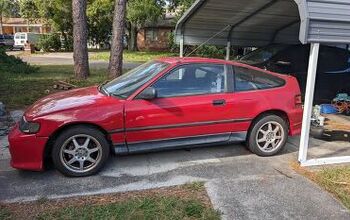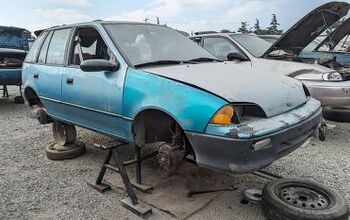How To Be An Automotive Journalist, Part III: Pathetic "Platform" Prose

There are times I really wish I had half the brains, knowledge, and skill of the average print-rag journo. Today is one of those times. You see, in my not-so-spare time, my race team and I have designed a lower control-arm brace for the first-generation Neon. It’s a neat thing, looks very industrial. I’m making it right here in Ohio, using 5000-series aluminum for corrosion resistance. The parts are laser-cut, and we have some semi-sophisticated CAD modeling tools involved to ensure it’s as strong as possible for the given weight. I’ll have the first batch of fifty in my hands this upcoming Friday.
Now here’s the big question. Will this brace fit the second-generation Neon? For the last decade, I’ve been reading various assertions by “automotive journalists” that the “PL2000” Neon is really the same “platform” as the first-gen car. If that’s really true — if all Neons are the same under the skin — this brace should bolt right up and we won’t have to go back to the CATIA screen to design a different one. We could sell a lot of them to owners of the newer Neons and SRT-4s. What do you think? Would you double your planned production run based on what you’ve read in Car and Driver? Of course not. Instead, we’re heading to the junkyard with a prototype to measure and check.
What the hell is a “platform” anyway? Once upon a time, a “platform” was called a “chassis”. Many early motorists ordered a chassis and engine from one manufacturer and had it “bodied” elsewhere. Nearly all of the automobiles built before the Second World War could be driven around without their bodies. The use of a Model T sans body as a kind of hillbilly proto-ATV was particularly popular. As late as 1966, Rolls-Royce had two different “coachbuilders” create unibody Silver Shadow coupes. James Young created a Shadow Coupe with a straight beltline; Mulliner Park Ward built a dipped-waist variant that became the Corniche.
Don’t rush down to your local Ford dealer and ask to buy a “D3 chassis”, because there’s no such thing. We are deep in the unibody era now and you couldn’t put a Flex body on a Taurus sedan floorpan without the assistance of a dozen expert fabricators and hundreds, possibly thousands, of labor hours. Same goes for making a Highlander out of a Camry, or a Flying Spur out of a Phaeton.
A platform is really a concept. It’s a set of shared measurements and designs. It’s a way to avoid doing some obscenely expensive first-principle engineering. Example: Honda designed a solid, well-proven suspension, engine mounting system, and set of “hard point” locations for HVAC/electronics/seat mounting for the Accord. By beefing-up those designs but keeping the same basic principles, they could make them work under a minivan, thus the Odyssey. And once you have those pieces in your inventory, why not build an SUV with them? It’s entirely possible that someday, somewhere, somebody will assemble four-wheel-drive, jacked-up Accords using Pilot components. If they bolt together, that is. The only way to know for sure is to measure it out and then do it.
Thirty years ago, the American automakers were under pressure. From Wall Street, to churn quarterly profit. From the government, to be “responsible”. From the public, to turn out a halfway decent product. Chrysler and General Motors decided to very publicly discuss the “X-body”, “K-car”, and “J-platform” when introducing their new vehicles. Doing so satisfied Wall Street: it was obviously cheaper to have a common underlying platform. It satisfied the governmental authorities, who not-so-secretly yearned for the day they would be able to mandate a single kind of car for everyone. And it satisfied the public that all the new cars, whether they were Citations, Skylarks, Omegas, or Phoenixes, had the latest engineering. But did anybody stop to ask if it was true?
I’m serious. For all anybody really knew, the Cimarron and the Cavalier could have been totally different under the skin. Sometimes the “platform twins” really were different, even if they had the same nameplate on them. Try swapping doors among the “G-body” Regal, Cutlass, and Malibu. They don’t always fit. Some critical dimensions were changed for the different assembly plants. What I’m getting at here, though, is that in automotive “journalism” we assume the manufacturer is telling the truth, unless it conflicts with our preconceptions.
Every automotive journalist in America implicitly accepted that the 1981 Aries and Reliant were the same car. Nobody measured them out. Nobody swapped parts just to check. They just took Chrysler’s word on the subject. Nothing’s changed in the past thirty years. All the babbling in the press about, say, the new Explorer, is just that — babbling. Nobody’s done the work to see just how different the Explorer is from the Flex under the skin. We all took Ford’s word that the two are related. What else can we do in the space of a hour-long test drive along a pre-planned route?
This leaves journalists with a problem, namely: If I get all my “platform” information from the manufacturers, how can I sound more insightful than my peers without actually doing any work? The answer is to make stuff up. I won’t link to examples of these assertions, particularly since a few of the links would have the same basic URL as found in this article, but how often have you read statements like:
- The Cavalier was “fundamentally the same” throughout its 23-year run, and the Cobalt uses the same basic platform as its predecessor?
- The Ford Panthers are “the same car underneath” from 1980 to 2010?
- The (insert name of full-sized truck or van here) hasn’t “really” changed since (1970-something)?
- The Chrysler 300 is just an old W210 E-Class “in drag”?
All of the above assertions are exposed for the garbage they are the minute you look underneath the vehicles in question with any kind of tape measure or caliper, but they sound very knowledgeable when you read them on a website or in a magazine. It’s lazy journalism at its finest, spouting ridiculous, uninformed assumptions as loud as humanly possible.
Note that I used American and/or German manufacturers for the examples above. The reason I did that? The Japanese aren’t stupid. For a long time now, they have carefully controlled the information they dole out regarding platform-sharing. That’s why the Civic and Corolla are always called “all-new” by the sycophantic press and the domestic subcompacts are always “carryover” this and “reused” that.
As someone who has raced a few Hondas and worked in a race garage with a few more, I can tell you from firsthand, turn-the-wrench experience that there are tremendous similarities between any two consecutive generations of Civics. Why is the press silent on this? It’s simple. Honda doesn’t think they have a need to know about commonalities, so Honda doesn’t tell them, and there’s obviously no way these fat-ass buffet hounds will find out on their own. It’s a brilliant strategy.
For more than thirty years, the Motor Trends of the world have swallowed and unthinkingly repeated the ridiculous idea that Japanese automakers effortlessly clean-sheet their entire lineup every four years while the domestics and Germans drag “platforms” out for decade-plus life spans. Two hours in a garage with a few tape measures would have exposed the falsehood — but who’s gonna do that when there are free drinks available at the hotel bar?
The irony of this is that Honda’s relentless determination to reuse critical dimensions, designs, and even bolts is a key factor in ensuring their famous reliability. It also allows NASA Honda Challenge race teams to “LEGO-set” some pretty neat cars. Want to put a Cobalt SS turbo engine in an ’02 Cavalier? No freakin’ way, not without a plasma torch. Want to put a Prelude engine in a CRX? Check out HondaSwap for the instructions. Those people know how similar most Hondas are, but they aren’t writing the “Wheels” section in your local newspaper.
The manufacturers are all wising-up to the fact that autojournos are too stupid to do their research on platforms. During the recent Cruze introduction, Chevrolet PR people repeatedly made semi-misleading “platform chat” assertions to link the Cruze with the Opel Astra, forgetting to mention that, while the Cruze is a “platform mate” with the Astra, it’s also a near-complete twin of a Daewoo. The recent Scion tC launch barely mentioned the Toyota Avensis, and furthermore, the Toyota PR people absolutely refused to speculate on whether the tC was a refreshed first-gen Avensis platform or a second-gen Avensis platform, or even if said two Avensis generations were different in any substantial way.
This isn’t stopping my fellow journalists from boldly forging ahead with new platform-based diatribes. One fellow recently wrote that the 370Z was a “converted truck”, citing the commonality with the Infiniti FX. That’s in-your-face writing, and it sounds quite knowledgeable. I wonder if the author of that piece could list any common pieces between a 370Z and an FX50? If he can, do you suppose he also knows if the lower strut brace I tested on my 1995 Plymouth Neon will fit a 2004 Dodge SRT-4?

More by Jack Baruth
Latest Car Reviews
Read moreLatest Product Reviews
Read moreRecent Comments
- Lou_BC "wait until 30 minutes after eating" My strategy for reading TTAC ;)
- THX1136 "Meet the new boss, same as the old boss" P. Townsend
- Bankerdanny I used to love the Chicago show. I went to my first one around 1980 and didn't miss it for another 20 years. After college I would take some vacation time so I could go mid-week when the show was less crowded. But I think I have only gone twice in the past 10 years. There just isn't much that interests me any more and the Detroit 3 started emphasizing the Detroit show over Chicago, so we weren't getting the big debuts like we used to. Ticket prices are ridiculous and food and drink charges are slices of pizza at steak prices.
- FreedMike Mandates are a bad idea. That's all.
- FreedMike Lots of fun, but this one needs a manual.





































Comments
Join the conversation
Any news on the Neon measurement?
Jack, I'm not sure, but I have a guess: Not only will the brace probably not fit, it appears that the late model Neons and SRT-4s are different to each other. It appears that the SRT-4s share that underpinning with the PT Cruiser, however. (About as non-ideal a platform sharing arrangement as possible for a performance part builder...) Source: car-part.com search for control arms for a 2004 Neon